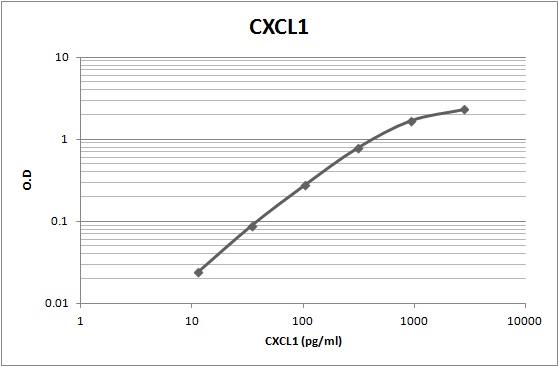Human/Primate CXCL1/GRO alpha /KC/CINC-1 Biotinylated Antibody
Human/Primate CXCL1/GRO alpha /KC/CINC-1 Biotinylated Antibody Summary
Ala35-Asn107
Accession # P09341
Applications
Human/Primate CXCL1/GRO alpha Sandwich Immunoassay
Please Note: Optimal dilutions should be determined by each laboratory for each application. General Protocols are available in the Technical Information section on our website.
Preparation and Storage
- 12 months from date of receipt, -20 to -70 °C as supplied.
- 1 month, 2 to 8 °C under sterile conditions after reconstitution.
- 6 months, -20 to -70 °C under sterile conditions after reconstitution.
Background: CXCL1/GRO alpha/KC/CINC-1
The gene for CXCL1/GRO alpha was initially discovered in hamster cells, using subtractive hybridization techniques, as a message that is over-expressed in tumorigenic cells and in normal cells during growth stimulation. The hamster cDNA was cloned and used as a probe for the subsequent cloning of the human GRO cDNA. Independently, a cDNA encoding a secreted protein with melanoma growth stimulating activity (MGSA) was also cloned from a human melanoma cell line and found to be identical to GRO. In addition to the initially cloned GRO gene, now designated CXCL1, two additional GRO genes, GRO beta or MIP-2 alpha and GRO gamma or MIP‑2 beta, which shared 90% and 86% amino acid sequence homology, respectively, with CXCL1, have been identified. All three human GROs are members of the alpha (C-X-C) subfamily of chemokines.
The three GRO cDNAs encode 107 amino acid precursor proteins from which the N-terminal 34 amino acid residues are cleaved to generate the mature GROs. There are no potential N-linked glycosylation sites in the amino acid sequences. GRO expression is inducible by serum or PDGF and/or by a variety of inflammatory mediators, such as IL-1 and TNF, in monocytes, fibroblasts, melanocytes and epithelial cells. In certain tumor cell lines, GRO is expressed constitutively.
Similar to other alpha chemokines, the three GRO proteins are potent neutrophil attractants and activators. In addition, these chemokines are also active toward basophils. All three GROs can bind with high affinity to the IL-8 receptor type B. It remains to be seen if a unique GRO receptor(s) also exist. The rat homolog of human CXCL1, CINC, is much more active than human CXCL1 on rat neutrophils, suggesting that this cytokine may have selective species specificity.
Product Datasheets
Citations for Human/Primate CXCL1/GRO alpha /KC/CINC-1 Biotinylated Antibody
R&D Systems personnel manually curate a database that contains references using R&D Systems products. The data collected includes not only links to publications in PubMed, but also provides information about sample types, species, and experimental conditions.
6
Citations: Showing 1 - 6
Filter your results:
Filter by:
-
Angiogenic Role of Mesothelium-Derived Chemokine CXCL1 During Unfavorable Peritoneal Tissue Remodeling in Patients Receiving Peritoneal Dialysis as Renal Replacement Therapy
Authors: Rusan Ali Catar, Maria Bartosova, Edyta Kawka, Lei Chen, Iva Marinovic, Conghui Zhang et al.
Frontiers in Immunology
-
Fusobacterium nucleatum host-cell binding and invasion induces IL-8 and CXCL1 secretion that drives colorectal cancer cell migration
Authors: Michael A. Casasanta, Christopher C. Yoo, Barath Udayasuryan, Blake E. Sanders, Ariana Umaña, Yao Zhang et al.
Science Signaling
-
IL-33 Attenuates Sepsis by Inhibiting IL-17 Receptor Signaling through Upregulation of SOCS3
Authors: R Lv, J Zhao, M Lei, D Xiao, Y Yu, J Xie
Cell. Physiol. Biochem., 2017-08-09;42(5):1961-1972.
Species: Human
Sample Types: Serum
Applications: ELISA Development (Detection) -
Nlrp12 mutation causes C57BL/6J strain-specific defect in neutrophil recruitment
Authors: Tyler K. Ulland, Nidhi Jain, Emma E. Hornick, Eric I. Elliott, Gwendolyn M. Clay, Jeffrey J. Sadler et al.
Nature Communications
-
Rapid chemokine secretion from endothelial cells originates from 2 distinct compartments.
Authors: Oynebraten I, Bakke O, Brandtzaeg P, Johansen FE, Haraldsen G
Blood, 2004-03-25;104(2):314-20.
Species: Human
Sample Types: Whole Cells
Applications: ICC -
Imbalance in the expression of CXC chemokines correlates with bronchoalveolar lavage fluid angiogenic activity and procollagen levels in acute respiratory distress syndrome.
Authors: Keane MP, Donnelly SC, Belperio JA, Goodman RB, Dy M, Burdick MD, Fishbein MC, Strieter RM
J. Immunol., 2002-12-01;169(11):6515-21.
Species: Human
Sample Types: BALF
Applications: ELISA Development
FAQs
No product specific FAQs exist for this product, however you may
View all Antibody FAQsReviews for Human/Primate CXCL1/GRO alpha /KC/CINC-1 Biotinylated Antibody
Average Rating: 5 (Based on 1 Review)
Have you used Human/Primate CXCL1/GRO alpha /KC/CINC-1 Biotinylated Antibody?
Submit a review and receive an Amazon gift card.
$25/€18/£15/$25CAN/¥75 Yuan/¥2500 Yen for a review with an image
$10/€7/£6/$10 CAD/¥70 Yuan/¥1110 Yen for a review without an image
Filter by:


